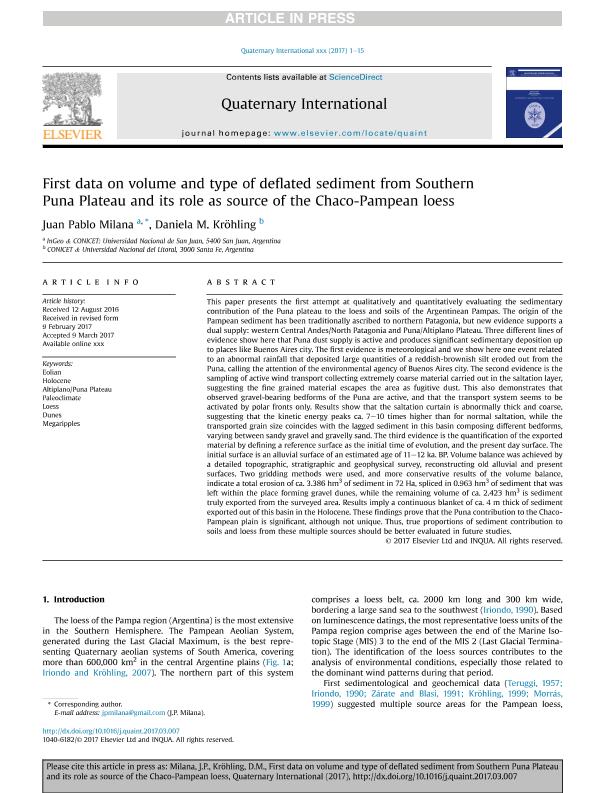Mostrar el registro sencillo del ítem
dc.contributor.author
Milana, Juan Pablo

dc.contributor.author
Krohling, Daniela Mariel Ines

dc.date.available
2018-08-15T19:24:09Z
dc.date.issued
2017-05
dc.identifier.citation
Milana, Juan Pablo; Krohling, Daniela Mariel Ines; First data on volume and type of deflated sediment from Southern Puna Plateau and its role as source of the Chaco-Pampean loess; Pergamon-Elsevier Science Ltd; Quaternary International; 438; 5-2017; 126-140
dc.identifier.issn
1040-6182
dc.identifier.uri
http://hdl.handle.net/11336/55716
dc.description.abstract
This paper presents the first attempt at qualitatively and quantitatively evaluating the sedimentary contribution of the Puna plateau to the loess and soils of the Argentinean Pampas. The origin of the Pampean sediment has been traditionally ascribed to northern Patagonia, but new evidence supports a dual supply: western Central Andes/North Patagonia and Puna/Altiplano Plateau. Three different lines of evidence show here that Puna dust supply is active and produces significant sedimentary deposition up to places like Buenos Aires city. The first evidence is meteorological and we show here one event related to an abnormal rainfall that deposited large quantities of a reddish-brownish silt eroded out from the Puna, calling the attention of the environmental agency of Buenos Aires city. The second evidence is the sampling of active wind transport collecting extremely coarse material carried out in the saltation layer, suggesting the fine grained material escapes the area as fugitive dust. This also demonstrates that observed gravel-bearing bedforms of the Puna are active, and that the transport system seems to be activated by polar fronts only. Results show that the saltation curtain is abnormally thick and coarse, suggesting that the kinetic energy peaks ca. 7–10 times higher than for normal saltation, while the transported grain size coincides with the lagged sediment in this basin composing different bedforms, varying between sandy gravel and gravelly sand. The third evidence is the quantification of the exported material by defining a reference surface as the initial time of evolution, and the present day surface. The initial surface is an alluvial surface of an estimated age of 11–12 ka. BP. Volume balance was achieved by a detailed topographic, stratigraphic and geophysical survey, reconstructing old alluvial and present surfaces. Two gridding methods were used, and more conservative results of the volume balance, indicate a total erosion of ca. 3.386 hm3 of sediment in 72 Ha, spliced in 0.963 hm3 of sediment that was left within the place forming gravel dunes, while the remaining volume of ca. 2.423 hm3 is sediment truly exported from the surveyed area. Results imply a continuous blanket of ca. 4 m thick of sediment exported out of this basin in the Holocene. These findings prove that the Puna contribution to the Chaco-Pampean plain is significant, although not unique. Thus, true proportions of sediment contribution to soils and loess from these multiple sources should be better evaluated in future studies.
dc.format
application/pdf
dc.language.iso
eng
dc.publisher
Pergamon-Elsevier Science Ltd

dc.rights
info:eu-repo/semantics/openAccess
dc.rights.uri
https://creativecommons.org/licenses/by-nc-sa/2.5/ar/
dc.subject
Altiplano/Puna Plateau
dc.subject
Dunes
dc.subject
Eolian
dc.subject
Holocene
dc.subject
Loess
dc.subject
Megaripples
dc.subject
Paleoclimate
dc.subject.classification
Meteorología y Ciencias Atmosféricas

dc.subject.classification
Ciencias de la Tierra y relacionadas con el Medio Ambiente

dc.subject.classification
CIENCIAS NATURALES Y EXACTAS

dc.title
First data on volume and type of deflated sediment from Southern Puna Plateau and its role as source of the Chaco-Pampean loess
dc.type
info:eu-repo/semantics/article
dc.type
info:ar-repo/semantics/artículo
dc.type
info:eu-repo/semantics/publishedVersion
dc.date.updated
2018-08-15T14:20:14Z
dc.journal.volume
438
dc.journal.pagination
126-140
dc.journal.pais
Estados Unidos

dc.journal.ciudad
Nueva York
dc.description.fil
Fil: Milana, Juan Pablo. Consejo Nacional de Investigaciones Científicas y Técnicas. Centro Científico Tecnológico Conicet - San Juan. Centro de Investigaciones de la Geosfera y Biosfera. Universidad Nacional de San Juan. Facultad de Ciencias Exactas Físicas y Naturales. Centro de Investigaciones de la Geosfera y Biosfera; Argentina
dc.description.fil
Fil: Krohling, Daniela Mariel Ines. Consejo Nacional de Investigaciones Científicas y Técnicas. Centro Científico Tecnológico Conicet - Santa Fe; Argentina. Universidad Nacional del Litoral; Argentina
dc.journal.title
Quaternary International

dc.relation.alternativeid
info:eu-repo/semantics/altIdentifier/doi/http://dx.doi.org/10.1016/j.quaint.2017.03.007
dc.relation.alternativeid
info:eu-repo/semantics/altIdentifier/url/https://www.sciencedirect.com/science/article/pii/S1040618216310047
Archivos asociados
